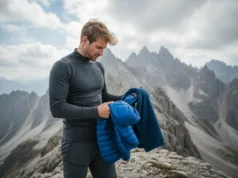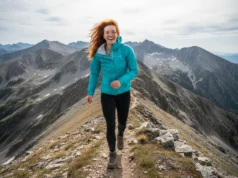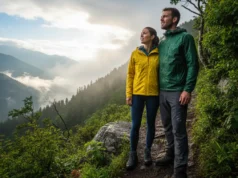In this article
Imagine you’re hours into a hike, high on a ridge in the Rocky Mountains, when the sky opens up. You pull on your rain jacket, but within twenty minutes, you’re soaked anyway—not from rain seeping in, but from a stifling, clammy sweat building up inside. The difference between a miserable retreat and a triumphant, comfortable day in the elements isn’t just having a rain jacket; it’s having the right rain jacket. This guide to the best women’s rain jackets for hiking moves beyond marketing claims to give you an expert framework for choosing a waterproof jacket that truly performs, keeping you dry from both the inside and out during any downpour.
This isn’t just about specs on a tag; it’s about matching the shell to the hiker. We’ll demystify the core differences between 2.5-layer and 3-layer construction and explain what waterproof and breathability ratings actually mean when you’re caught in a rainstorm. You’ll learn how to choose a rain jacket by identifying your own hiker persona—whether you’re an “All-Weather Adventurer,” a “Pragmatic Weekender,” or an “Ultralight Thru-Hiker”—to instantly narrow your focus. Critically, you’ll discover why a jacket’s physical vents often trump a fabric’s lab-tested breathability for real-world comfort. By the end, you’ll have direct, field-tested recommendations to confidently select the perfect shell for your adventures.
How to Choose the Right rain jacket waterproof womens: An Expert’s Framework
Making a smart, confident choice requires moving beyond brand loyalty and understanding the science of staying dry. This framework will arm you with the objective knowledge to diagnose your needs and evaluate the waterproof performance of a women’s hiking rain jacket.
What’s the Real Difference Between 2.5-Layer and 3-Layer Construction?
When you see “2.5L” or “3L” on a tag, it’s describing the layer construction of the waterproof fabric. Think of a 3-layer jacket as the workhorse of the rain shell world. It’s a durable sandwich: a tough outer face fabric is bonded to a waterproof/breathable membrane in the middle, which is then protected by a comfortable inner liner on the inside. This complete construction, featuring fully taped seams, provides superior durability against the abrasion of a backpack, feels much better against your skin, and is the undisputed champion for harsh conditions and frequent, demanding use, from alpine climbing to casual day hikes. It’s the shell you choose when reliability is paramount.
In contrast, a 2.5-layer jacket is the sprinter. It uses the same outer fabric and waterproof membrane, but instead of a full fabric liner, it has a very thin, printed or sprayed-on polyurethane “half layer” on the inside. This minimalist of construction types makes the jacket significantly lighter, more packable, and less expensive. The trade-off is reduced durability and a tendency for the inner surface to feel clammy or sticky against bare skin, although modern protective prints have greatly improved this sensation. Understanding this fundamental 2.5L vs 3L difference is the first step in knowing how this outer shell fits into a complete layering system.
How Much ‘Waterproof’ Is Enough? Decoding the Ratings
A jacket’s waterproofing is measured using a Hydrostatic Head (HH) test, which results in a rating in millimeters (mm). Imagine a tube of water sitting on the fabric; the waterproof rating (mm) is how high that column of water can get before it forces its way through. For real-world hiking, a rating up to 10,000mm is sufficient for light drizzle or as an emergency shell you hope not to use. For reliable, all-day protection in sustained rain and the kind of wind-driven downpours you find in the mountains, you should look for a rating of 15,000mm to 20,000mm or more for great waterproofing.
But the waterproof fabric itself is only half the story. The outer surface of every rain jacket is treated with a Durable Water Repellent (DWR) finish, often a PFC-free formula in modern jackets for better sustainability. This coating is what makes water bead up and roll off. When this DWR wears off from dirt, abrasion, or body oils, the outer fabric gets saturated and “wets out.” While the underlying membrane might still be preventing a leak, a wetted-out jacket feels cold, heavy, and its breathability plummets, making you feel damp and clammy from internal moisture. You can learn more about how this works from this excellent REI guide on rainwear.
Pro-Tip: You can tell your DWR is failing if water starts to darken and soak into the fabric instead of beading up. To reactivate it, first clean the jacket with a technical wash, then tumble dry it on low heat for about 20 minutes. The warmth helps restore the water-repellent finish. Care and maintenance are key to a jacket’s longevity.
Why Are Pit Zips So Important? Breathability vs. Ventilation
Keeping rain out is one challenge; letting your sweat escape is another. A fabric’s ability to do this is called breathability, often measured as a Moisture Vapor Transmission Rate (MVTR) in grams per square meter per 24 hours (g/m²/24hr). A higher breathability rating (g/m²), with numbers over 20,000g, is excellent for high-output activities like trail running or fast-and-light ascents. This is the fabric’s job.
However, the jacket’s job is ventilation, and this is arguably more important on the trail. The hard truth is that no waterproof breathable fabric on earth can transport moisture as fast as a hiker generates it on a steep, grueling climb. This is where mechanical vents, especially the underarm zippers known as “pit zips,” become critical for venting. They allow you to physically dump huge amounts of heat and moisture-laden air instantly, managing your internal climate far more effectively than fabric alone. A jacket with average breathability but massive pit zips will almost always keep you more comfortable during hard exercise than a top-tier breathable jacket with no vents at all. For most three-season hiking, pit zips are a non-negotiable feature and one of the most essential beginner hiking tips for staying comfortable.
Pro-Tip: Don’t wait until you’re overheating. Open your pit zips at the start of a strenuous climb, not halfway through. It’s far easier to stay dry from the inside out than it is to get dry once you’ve started sweating heavily.
Our Selection Process: How We Built This Guide
Our commitment is to objectivity. We aren’t loyal to specific brands like The North Face or Marmot; we are loyal to performance on the trail. The entire purpose of this guide is to empower you with the data, context, and expert insight to choose the jacket that best serves your specific hiking needs, budget, and philosophy. We want to help you find the best womens rain jacket for your adventures.
To do this, we built a rigorous evaluation framework, our “hiker profile decision matrix”. Every hiking waterproof jacket for women considered for this guide was analyzed against six core performance pillars: Weather Protection, Breathability & Ventilation, Comfort & Mobility, Weight & Packability, Durability (considering fabric denier), and overall Feature Set, including hood adjustability and pocket placement.
Our selection process and rain jacket testing began with a market-wide analysis of over 50 women’s rain jackets. We synthesized data from independent lab tests, expert field reviews from publications we trust, and thousands of hours of real-world user feedback from across the hiking community. We then filtered this massive dataset through our “hiker personas” framework, ensuring that every jacket we recommend isn’t just a good product, but a best-in-class solution for a specific type of hiker and their unique priorities, creating a trail-ready checklist for your next purchase.
A quick note on affiliate links: If you find this guide helpful and choose to purchase through our links, we may earn a small commission at no extra cost to you. This support is what fuels our independent testing and research. We only recommend gear we genuinely believe in and would use ourselves.
The Best Rain Jackets for Women Hikers of 2025: Our Top Recommendations for Every Need
With the technical specifications laid out, it’s time to find your perfect match. We’ve curated our top recommendations for the key hiker profiles, allowing you to quickly and confidently find the jacket that aligns with your needs.
Our Top Picks for The All-Weather Adventurer
You are the hiker who ventures out when others turn back. You might be an alpine scrambler or someone who enjoys hiking in the shoulder seasons. You need absolute, “bomber” reliability for the harshest conditions, from the alpine ridges of the Chugach Range to the notoriously wet trails of the Pacific Northwest. Your priorities are maximum weather protection and long-term durability. You understand that the most protective rain jacket often comes with a higher price tag and a few extra ounces in your pack.
Our Top Picks for The Pragmatic Weekender
You are the heart of the hiking community, a true weekend warrior. Your adventures are day hikes and weekend backpacking trips, and you need the most versatile rain jacket that nails the sweet spot of performance, weight, and value. You work hard on the ascents and know that dumping heat is key to staying comfortable, making pit zips an absolute must-have feature for your do-it-all shell. This is your super comfortable rain jacket.
Our Top Picks for The Ultralight Thru-Hiker
For you, ounces make pounds, and pounds make pain. You are the ultralight thru-hiker. Your world is one of long-distance efficiency on trails like the CDT or Long Trail, where every piece of gear is scrutinized for its weight and packed volume. Your primary goal is to carry the lightest, most compact rain protection possible. You knowingly trade some features and long-term durability for featherlight performance, viewing your rain shell as a critical but minimalist piece of emergency gear. This is the best emergency and best ultralight rain jacket.
Conclusion
There is no single best rain jacket overall for women. The ideal shell is the one that perfectly aligns with your specific hiking profile, your budget, and the weather conditions you most often face. For all-around three-season hiking, remember to prioritize functional features like pit zips for ventilation, as they often have a greater impact on your comfort than a fabric’s breathability rating. A durable and long-lasting 3-layer construction is a wise investment for frequent, hard use, while a minimalist 2.5-layer build is the clear winner for those who prioritize weight savings and packability above all else. A waterproof rating in the 15,000-20,000mm range will provide more than enough protection for nearly any storm you’ll encounter on the trail.
Armed with this knowledge, you can now look past the marketing hype. Identify your hiker profile, prioritize the features that truly matter to you, and invest in the jacket that will keep you hiking confidently and comfortably, no matter what Mother Nature decides to do.
Frequently Asked Questions about Women’s Hiking Rain Jackets
What is the real difference between a $100 rain jacket and a $400 one?
The primary differences lie in the fabric construction, long-term durability, and feature set, which drives the value justification. A $400 jacket, like an Arc’teryx shell, typically uses a premium 3-layer GORE-TEX fabric that is more durable, more breathable, and feels more comfortable against the skin. It also features higher-end construction details like advanced hood designs and laminated, watertight zippers. A $100 jacket, often the best budget rain jacket option, more often uses a 2.5-layer fabric, which is less durable and can feel clammier but saves significant cost and weight. For an excellent value proposition, consider a jacket like the Patagonia Torrentshell 3L, which offers the durability of a 3-layer construction for under $200.
Do I really need pit zips in a rain jacket?
Yes, for most active three-season hiking, pit zips are one of the most critical features for maintaining comfort. No matter how “breathable” a fabric is, it simply cannot expel moisture as quickly as you produce it during a strenuous uphill climb. Pit zips allow you to mechanically vent a massive amount of hot, humid air instantly. This is why jackets with superior ventilation, like the Outdoor Research Aspire 3L, often feel more comfortable during hard exercise than jackets made with more technically “breathable” fabrics but no vents.
Is a GORE-TEX jacket automatically better?
Not necessarily. GORE-TEX has established itself as a benchmark for high-quality waterproof/breathable performance, and you can trust it to perform. However, many top brands have developed their own proprietary waterproof technology, such as Patagonia’s H2No, Outdoor Research’s AscentShell, and The North Face’s FUTURELIGHT, that offer excellent and highly comparable performance, often at a more competitive price. Instead of focusing only on the GORE-TEX brand name, it’s more effective to evaluate the jacket’s overall construction (2.5-layer vs. 3-layer) and its feature set (like pit zips and pocket placement) to see if it meets your specific needs.
What does a waterproof rating like “20,000 mm” actually mean?
This rating, derived from a Hydrostatic Head test, measures how much water pressure a fabric can withstand before it begins to leak. A 20,000mm rating means the fabric can hold up a 20-meter-tall column of water before failing. In practical terms, this is considered highly waterproof and is more than sufficient for withstanding heavy, wind-driven rain during a hike. While higher numbers are technically better, most quality jackets from reputable brands, such as the Arc’teryx Beta or Patagonia Torrentshell 3L, provide ample waterproof protection for any conditions you will realistically encounter on the trail.
Risk Disclaimer: Hiking, trekking, backpacking, and all related outdoor activities involve inherent risks which may result in serious injury, illness, or death. The information provided on The Hiking Tribe is for educational and informational purposes only. While we strive for accuracy, information on trails, gear, techniques, and safety is not a substitute for your own best judgment and thorough preparation. Trail conditions, weather, and other environmental factors change rapidly and may differ from what is described on this site. Always check with official sources like park services for the most current alerts and conditions. Never undertake a hike beyond your abilities and always be prepared for the unexpected. By using this website, you agree that you are solely responsible for your own safety. Any reliance you place on our content is strictly at your own risk, and you assume all liability for your actions and decisions in the outdoors. The Hiking Tribe and its authors will not be held liable for any injury, damage, or loss sustained in connection with the use of the information herein.
Affiliate Disclosure: We are a participant in the Amazon Services LLC Associates Program, an affiliate advertising program designed to provide a means for us to earn advertising fees by advertising and linking to Amazon.com. As an Amazon Associate, we earn from qualifying purchases. We also participate in other affiliate programs and may receive a commission on products purchased through our links, at no extra cost to you. Additional terms are found in the terms of service.





